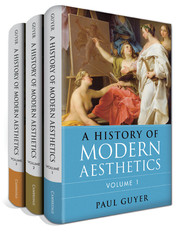Book contents
- Volume 1 The Eighteenth Century
- Volume 2 The Nineteenth Century
- Volume 3 The Twentieth Century
- Frontmatter
- Contents
- Acknowledgments
- Introduction
- Part One German Aesthetics in the Twentieth Century
- Part Two Aesthetics in Britain until World War II
- 3 Bloomsbury, Croce, and Bullough
- 4 First Responses to Croce
- 5 Collingwood
- Part Three American Aesthetics in the First Half of the Twentieth Century
- Part Four Wittgenstein and After
- Bibliography
- References
4 - First Responses to Croce
from Part Two - Aesthetics in Britain until World War II
Published online by Cambridge University Press: 05 June 2015
- Volume 1 The Eighteenth Century
- Volume 2 The Nineteenth Century
- Volume 3 The Twentieth Century
- Frontmatter
- Contents
- Acknowledgments
- Introduction
- Part One German Aesthetics in the Twentieth Century
- Part Two Aesthetics in Britain until World War II
- 3 Bloomsbury, Croce, and Bullough
- 4 First Responses to Croce
- 5 Collingwood
- Part Three American Aesthetics in the First Half of the Twentieth Century
- Part Four Wittgenstein and After
- Bibliography
- References
Summary
Having looked at the independent Bullough, we can now return to the impact of Croce on British aesthetics from the turn of the twentieth century until World War II. We shall see that those who remained closest to Croce, such as E.F. Carritt and Louis Arnaud Reid, nevertheless broke with him on the issue of the materiality of art, while Samuel Alexander used the issue of materiality to depart more radically from Croce. Ironically, the author who in many ways tried to remain closest to Croce, namely, Collingwood, ended up not only breaking with him on the issue of materiality but also more fully recognized imaginative activity as central to aesthetic experience and thus came closer to a more comprehensive approach to aesthetics than his master had.
Carritt
The first of the British aestheticians to be influenced by Croce was Edgar Frederick Carritt (1876–1964). Carritt was a fellow of University College at Oxford, where he was associated with both the Oxford realism of John Cook Wilson in theoretical philosophy and the Oxford intuitionism in moral philosophy of H.A. Prichard and David Ross. Carritt published numerous works in moral and political philosophy, including The Theory of Morals (1928), Ethical and Political Thinking (1947), and Morals and Politics (1952), and was known for his polemics against utilitarianism, Hegel’s political theory, and Marxist dialectical materialism. But he was known earliest and remains best known for his work in aesthetics, and we shall consider that work here. Carritt originally laid out his views in The Theory of Beauty, first published in 1914; he also published a widely used anthology of texts in aesthetics, Philosophies of Beauty: From Socrates to Robert Bridges, Being the Sources of Aesthetics, and two introductions to aesthetics, What Is Beauty? A First Introduction to the Subject and Its Modern Theories and An Introduction to Aesthetics. He also produced A Calendar of British Taste from 1600 to 1800: Being a Museum of Specimens & Landmarks Chronologically Arranged. Like Collingwood, Carritt was also among those who helped translate Croce’s vast oeuvre into English. Our discussion of Carritt’s version of expressionism will be based on his original work, The Theory of Beauty, and the amplification of his conception of expression in his Introduction of thirty-five years later.
- Type
- Chapter
- Information
- A History of Modern Aesthetics , pp. 158 - 188Publisher: Cambridge University PressPrint publication year: 2014



